中美企业文化初探
- 格式:doc
- 大小:28.50 KB
- 文档页数:3
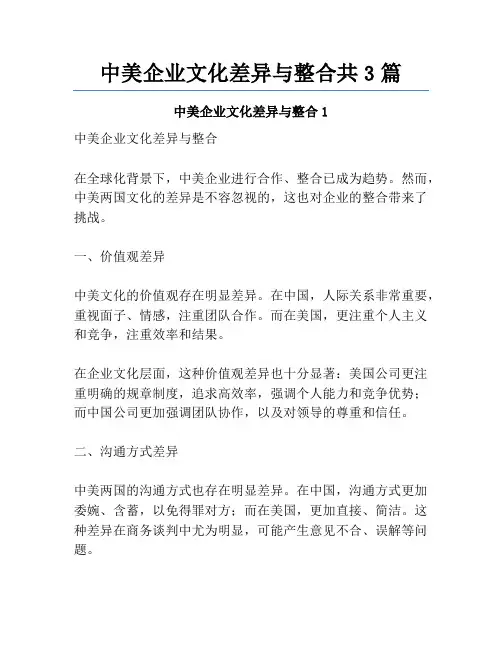
中美企业文化差异与整合共3篇中美企业文化差异与整合1中美企业文化差异与整合在全球化背景下,中美企业进行合作、整合已成为趋势。
然而,中美两国文化的差异是不容忽视的,这也对企业的整合带来了挑战。
一、价值观差异中美文化的价值观存在明显差异。
在中国,人际关系非常重要,重视面子、情感,注重团队合作。
而在美国,更注重个人主义和竞争,注重效率和结果。
在企业文化层面,这种价值观差异也十分显著:美国公司更注重明确的规章制度,追求高效率,强调个人能力和竞争优势;而中国公司更加强调团队协作,以及对领导的尊重和信任。
二、沟通方式差异中美两国的沟通方式也存在明显差异。
在中国,沟通方式更加委婉、含蓄,以免得罪对方;而在美国,更加直接、简洁。
这种差异在商务谈判中尤为明显,可能产生意见不合、误解等问题。
三、组织结构差异中美企业的组织结构存在一定差异。
在美国,公司的决策偏向于平面化和去中心化,由每个部门的负责人共同管理。
而在中国,公司的结构更趋向于集中化,领导者的权威和决策更加集中。
四、员工关系差异在管理员工方面,中美两国也存在巨大差异。
在美国,公司对员工的要求更高,员工获得更多自由度和选择空间,也更加重视员工的个人成长和福利。
而在中国,员工与公司的关系更像家庭,更加注重保障员工的收入和就业机会。
如何整合?为了实现跨文化企业的顺利整合,企业需要采取以下措施:一、建立尊重差异的文化企业应尊重中美文化的差异,采取开放的文化政策,了解、理解和包容跨文化企业中不同的文化特点和习惯,形成温馨、和谐、开放和尊重的企业文化,让员工在工作中感到舒适和自由,提高员工的工作热情和创造力。
二、教育员工文化差异企业需要培训员工对文化差异的认识和理解,提高他们对不同文化的包容性和接纳能力,避免因为文化差异而产生的误解和冲突。
三、建立多元化的管理团队企业应该建立多元化的管理团队,包括不同国家的员工,以便在企业整合时有能力管理不同文化的员工。
四、促进沟通和交流为促进不同文化背景的员工之间的沟通和交流,企业可以采用多种沟通方法,例如建立员工服务中心、制定多元化的员工福利计划等,以此建立员工和企业之间的更好的关系,并帮助他们更好地适应不同文化的差异。
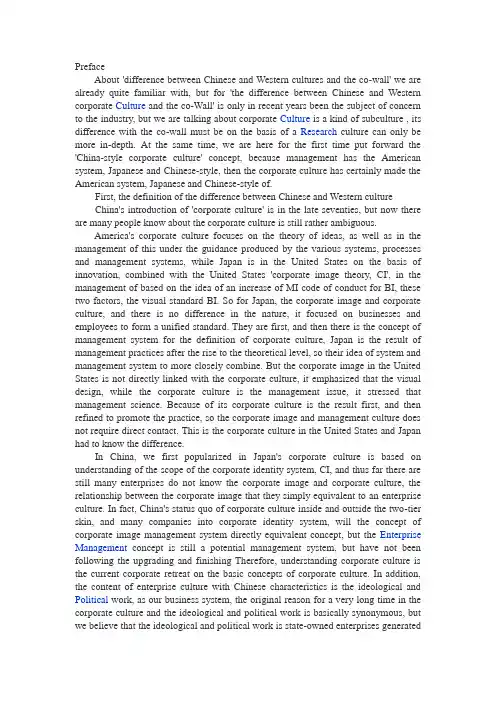
PrefaceAbout 'difference between Chinese and Western cultures and the co-wall' we are already quite familiar with, but for 'the difference between Chinese and Western corporate Culture and the co-Wall' is only in recent years been the subject of concern to the industry, but we are talking about corporate Culture is a kind of subculture , its difference with the co-wall must be on the basis of a Research culture can only be more in-depth. At the same time, we are here for the first time put forward the 'China-style corporate culture' concept, because management has the American system, Japanese and Chinese-style, then the corporate culture has certainly made the American system, Japanese and Chinese-style of.First, the definition of the difference between Chinese and Western cultureChina's introduction of 'corporate culture' is in the late seventies, but now there are many people know about the corporate culture is still rather ambiguous.America's corporate culture focuses on the theory of ideas, as well as in the management of this under the guidance produced by the various systems, processes and management systems, while Japan is in the United States on the basis of innovation, combined with the United States 'corporate image theory, CI', in the management of based on the idea of an increase of MI code of conduct for BI, these two factors, the visual standard BI. So for Japan, the corporate image and corporate culture, and there is no difference in the nature, it focused on businesses and employees to form a unified standard. They are first, and then there is the concept of management system for the definition of corporate culture, Japan is the result of management practices after the rise to the theoretical level, so their idea of system and management system to more closely combine. But the corporate image in the United States is not directly linked with the corporate culture, it emphasized that the visual design, while the corporate culture is the management issue, it stressed that management science. Because of its corporate culture is the result first, and then refined to promote the practice, so the corporate image and management culture does not require direct contact. This is the corporate culture in the United States and Japan had to know the difference.In China, we first popularized in Japan's corporate culture is based on understanding of the scope of the corporate identity system, CI, and thus far there are still many enterprises do not know the corporate image and corporate culture, the relationship between the corporate image that they simply equivalent to an enterprise culture. In fact, China's status quo of corporate culture inside and outside the two-tier skin, and many companies into corporate identity system, will the concept of corporate image management system directly equivalent concept, but the Enterprise Management concept is still a potential management system, but have not been following the upgrading and finishing Therefore, understanding corporate culture is the current corporate retreat on the basic concepts of corporate culture. In addition, the content of enterprise culture with Chinese characteristics is the ideological and Political work, as our business system, the original reason for a very long time in the corporate culture and the ideological and political work is basically synonymous, but we believe that the ideological and political work is state-owned enterprises generatedby the special context of a management culture, it's just the context of China's special part of corporate culture, rather than all the corporate culture more than Chinese culture in its entirety. We know that China's current forms of enterprises in addition to state-owned enterprises, there are foreign-funded enterprises and private enterprises, for them, the ideological and political work would not be equivalent to corporate culture. Therefore, the Chinese understanding of corporate culture is quite confusing at this stage, there are considered to be corporate image, there are considered to be ideological and political work, and even considered to be employees of the entertainment.From the above can be analyzed, the United States believes the corporate culture focused on management culture, Japan believes that the corporate culture focused on the image of culture. Chinese-style corporate culture that what should be the definition? We believe that the Chinese-style corporate culture should be 'philosophical-style corporate culture', both the philosophical and cultural. The so-called philosophy-style corporate culture refers to the corporate philosophy as the center, inside and outside the enterprise to transform a set of contradictory ways of thinking. This philosophical culture is characterized by: 'hardness with softness, dealt with gently; internally and externally within the main outer'. 'Hardness with softness, dealt with gently' management system is to rigid and flexible combination of management concepts and to management concept to guide management system, which is the management culture; 'internally and externally within the main outer' refers to the management culture and image of the culture of the times, and to guide the management culture of the image of culture. Can be seen, Chinese-style corporate culture combines the U.S. and Japanese corporate culture corporate culture advantages, while Innovation in a traditional Chinese cultural characteristics with a new model of corporate culture.Second, the difference between Chinese and Western management thinkingTalking about the differences between Chinese and Western culture, we must first understand the difference between Chinese and Western business management thinking, because differences in corporate culture is to manage the thinking behind the differences in management thinking is the core of corporate culture. The difference between Chinese and Western management thinking there are many aspects, but the most essential is the 'logic' and 'dialectical thinking,' the difference.Americans believe that logical thinking, which emphasizes the unity of the world, non-contradictory and scheduling neutral. By this way of thinking people believe that a proposition can not simultaneously right or wrong, or right, or wrong, no intermediate. Usually we say that they are 'either-or' thinking.Chinese people emphasize the dialectical thinking, which contains three principles: change theory, the contradiction theory and in theory. Change on the changing nature of departure from the world, that the world is ever changing, there is no eternal right and wrong; Contradiction believes that all things are composed of contradictions from the unity of opposites, there is no contradiction, nothing themselves, and in theory are embodied in the doctrine of the mean, that to everything there is a moderate reasonable.Third, the difference between Chinese and Western value systemDifferences in thinking in the West, under the influence of Western value systems have significant differences. Values is in us what is and what is wrong; what should and what should not be a criterion. Value system in general includes the basic values, and the value of goals, ways and restraint mechanisms to implement four aspects. We will classify and Western values, value is based on 'individualism and collectivism', the value of objective is to 'materialism and spiritualism,' implementation of the approach is' science of Marxism and the German-ism ', and restraint mechanism is' doctrine and the rule of man, the rule of law doctrine ', here we are in accordance with this classification method, the difference between Chinese and Western value systems are introduced.1, individualism and collectivismWesterners for the individual and collective thinking is focused on the collective from a personal perspective, they think that group is made up of individuals, so the focus on personal progress, emphasizes the role of individuals, ability, struggle, hard work and so on, so personal heroism is Western values is an important constituent element. As long as the opportunity to demonstrate their abilities, the Americans will be the first to fight, the champion with the record is almost an American word. And China's ways of thinking emphasize collectivism, used to analyze the individual from the collective, individual but collective in an integral part. Under the influence of such thinking, 'good deed goes unpunished, people are afraid afraid of famous pig Zhuang', 'I'm a brick, where the need to move there,' long-term guiding ideology of the Chinese people's management practices, thus forming a kind of ' a low-key, pragmatic 'cultural inclinations. Under the influence of such values, Westerners concerned about how their own view, and the Chinese people were concerned about how others look.2, materialism and spiritual doctrineFor the material needs of the West has always been considered justified, the pursuit of the interests of Social Development needs, but also a manifestation of personal values, so the values of excellence recognized by society standards. So the rich are respected in the community, there is no need for cover. The Chinese people always believe that traders 'materialistic sense' and therefore do not advocate emphasized that the material interests of promoting a cultural figures, emphasizing the pursuit of self self-cultivation is usually so as to achieve without me state, so abstinence can be said that a key feature of Chinese culture. 'Contentment''not seeking''active but they try too little wealth not only an' idea makes the development of Chinese enterprises lack a long-term ideological driving force.3, Scientism and Germany-based doctrineWestern advocates of science and reason, for the analysis things are built on a scientific, logical, analytical thinking, based on what is right what is wrong to distinguish very clearly, there is not much vague and uncertain claims on their , the 'right' is the 'right', 'wrong' is the 'wrong', it is easy to distinguish, to promote results-oriented, the sake of discussion. But the Chinese people have stressed the 'Heaven and Man', hope that, through their own internalized the value of practice to achieve the goal, 'immune', 'self-cultivation, regulating the family, ruling the state andthe world' is the representative of these values. Therefore, Chinese people are very emotional, what is 'not', 'right' is sometimes not necessarily 'wrong' is not all that is 'wrong', also in consideration of time, place, background, in particular, to pay attention to face the problem, the management thought the 'degree' difficult to grasp. However, the realm of German-based Education is too high, and even do not have much maneuverability. The Chinese concept of happiness is to some extent, ethics, and moral well-being equivalent to a.4, the rule of law doctrine and the rule of manismWestern assumptions about human nature is not the same, the West key assumptions that human nature is evil, therefore the emphasis of legal right to regulate people's behavior. They stressed that the establishment of the rule of law, all operations are based on law and therefore the relationship between people is a kind of contractual relationship, by the book value of market principles is the main trend. The Chinese culture focuses on human nature is good, so people can be enlightenment, and can be perception. The rule of man is concerned about the harmony between people, so the relationship of face for the relative legal, market, more important, do not understand the relationship between doing business in China principle is everywhere difficult, can be said that 'the door doors factions, all owned by circle '. Three cardinal guides and the formation of the five permanent members of the hierarchy of values, the concept of the will and so on.Fourth, differences between the operation of Chinese and Western culture1, Chinese and Western models of corporate culture differencesEstablished by the Western corporate culture, their business development time has been 100 years of history, management foundation is more thorough understanding of the scientific management and operational Experience of a mature, what is lacking is the management philosophy major traction, so that their corporate culture model is relatively simple, often merely to make a few core values that can be, and then under the direction of the core values, will manage the concept in the management systems and processes throughout the entire process, you can contact the practice to do philosophy, and cultural implementation of behavior.However, the current management situation of Chinese enterprises still remain in the experience of management to scientific management of the transition phase, many enterprises are relatively superficial understanding of scientific management, and more talks is not the cultural management of the stage, the corporate culture model can not be too simple, then in the primary stage of the scientific management of corporate culture can be difficult to truly reflect the system in the management of the road is only two layers of skin just inside and outside. Therefore, we believe that China's current application-oriented corporate culture corporate culture, it should be emphasized that a hierarchical model of stages to operate, we must carefully distinguish between core concepts, application ideas and dissemination of the distinction between ideas and more to the image of culture and management Cultural well together.2, the operation of Chinese and Western corporate culture differences in the wayWestern corporate culture is based on the theory of management science, so their culture is based on the Strategic Management model based on heavy content than form, although the construction of their corporate culture very much attention and investment, but few companies specifically to emphasize the work of the corporate culture or is classified into the corporate culture of their areas of work, so more of Western corporate culture is embodied in human resources, strategic management, brand marketing, among the various management systems, compare little the specialized agencies to the operation of corporate culture. But this did not reduce the corporate culture in their management system, the position or a role, with the Chinese measure of corporate culture, it should be said that their corporate culture more of a hidden and potential.China is now the corporate culture are actually remain in the exploratory stage, and not very sophisticated operation, or system of ideas. In general, more suitable for the current mode of operation should be comprehensive to promote breakthroughs in key areas, with actual situation. Comprehensively advance in the external image, internal management culture of the two systems should be comprehensive, because we are just getting started in these areas, there is no maturity model. Breakthroughs in the internal management culture, the Chinese-style management has no clear pattern can give us learn, so the management culture to talk about the stereotypes, how to find a suitable Chinese enterprises to the management of cultural patterns, this should be the Chinese-style the key to corporate culture. Actual situation is to combine the implementation of the way corporate culture take many forms, be practical, to empty, giving the false and true combined.5, Chinese and Western culture combined wallWestern corporate culture and Chinese culture have their own advantages and disadvantages, how is the Chinese-style Yangzhangbuduan the key issues shaping the corporate culture. As we have defined, Chinese-style corporate culture is a philosophy of culture, its emphasis is a dynamic equilibrium, transforming conflict, but it is definitely not without changing any of the principles is the principle under the conditions of certain changes in order to maintaining the status quo In changing to seek the same.1, philosophical and cultural connotationsAccording to the division of value system, we believe that philosophical culture, we must bear with the following aspects of the content, but we must stress that these values are not absolute contradiction between them, but a dynamic transformation, but there are certain principles of transformation, that is, who should Who is the principle of the post, or completely fell into unprincipled state.(1) the first individual and then collectivelyChina's traditional emphasis on collective rather dilute the cultural requirements of individuals, highlight the harmonious and weaken the competition, and the formation of egalitarianism, the phenomenon of eating big pot. Must therefore be based on maintaining the team spirit of individualism, empowerment doctrine, the establishment of performance management, promotion of values such as results-oriented. But it can not be simply interpreted as giving up the team spirit andstrengthen the individualism, in fact, the two are not contradictory, so individual members of the team, the team affected individuals.(2) the first material and then the spirit ofEnterprises are profitable can survive, but not just exist in order to survive. And people can not live only for money, but could not live without money. Maslow's theory tells us that people need is a stage, so we should pay attention to the material needs of employees, can not be expected only by spiritual orientation and require employees to give up the most basic requirements.(3) first and then arts and sciencesManagement is a science is art, if only the emphasis on art, it is easy to fall into the 'rule of man''Machiavellian' inside the trap and become nihilism, so that any art is science-based. Chinese-style corporate culture to emphasize the scientific basis for management to carry out art of management, strengthen basic management of construction, on the basis of rational sensibility.(4) The first system, then cultureHumans have two sides, but no matter what assumptions, business is not a religion, it does not use human beings as the ultimate goal of probation, it does not need to shoulder their social responsibility for the purpose of survival. Therefore, corporate culture should be guided by management system based on a relatively perfect system there is no management system to simply talk about the building of enterprise culture would only talk of culture, loss of institutional foundation of the corporate culture will make the cultural spirit of the building, empty of.2, China's current corporate culture and cultural factors need reinforcementAs China's integration with the international market continue to strengthen the depth and breadth of Chinese enterprises in the enterprise culture connotation, the depth and breadth of the need to constantly enhance and upgrade to meet the new market development needs, we called the corporate culture reinforcing factors.And cultural needs of Chinese enterprises reinforced main factors are:Ability doctrine: To advocate the establishment of competency-based corporate culture, dilute the 'No credit is also hard work' concepts, on this basis, foster results-oriented performance culture. At the same time to establish a level difference in pay and benefits, breaking the egalitarianism, except for eating big pot ideas. To change the Talent's 'ability and political integrity' concept to enhance the 'before' understanding of the company without violating the spirit and under the premise of social ethics, boldly newcomers to give up absolute 'loyalty' conception of qualified personnel.Open house: a positive absorption of a variety of new concepts and ideas, the introduction of different ideas, the premise of thinking in innovation management to maintain the dynamics of corporate culture to meet the development needs of the market, following the beaten track of thinking is the biggest enemy of corporate culture.Fair Competition: Although China relations-oriented culture is a major feature of traditional culture, but in an increasingly strong sense of market circumstances, the fair competition is the development trend of the market, so how to enhance businessawareness and market competition, enterprises need the ability enhanced ideology.Professional spirit: Chinese enterprises must strive to strengthen the professionalism of staff training to teach employees how to become a market economy under the conditions of a qualified professional staff, improve work efficiency, enhance professional responsibility.System Management: In the absence of a good system management infrastructure, stressed the role of the corporate culture of Marxism and nihilism easy rule of man-oriented corporate culture is based on the scientific management system.。
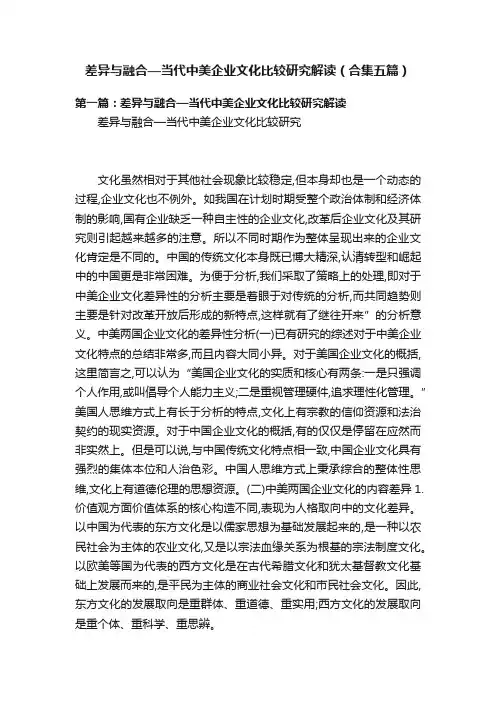
差异与融合—当代中美企业文化比较研究解读(合集五篇)第一篇:差异与融合—当代中美企业文化比较研究解读差异与融合—当代中美企业文化比较研究文化虽然相对于其他社会现象比较稳定,但本身却也是一个动态的过程,企业文化也不例外。
如我国在计划时期受整个政治体制和经济体制的影响,国有企业缺乏一种自主性的企业文化,改革后企业文化及其研究则引起越来越多的注意。
所以不同时期作为整体呈现出来的企业文化肯定是不同的。
中国的传统文化本身既已博大精深,认清转型和崛起中的中国更是非常困难。
为便于分析,我们采取了策略上的处理,即对于中美企业文化差异性的分析主要是着眼于对传统的分析,而共同趋势则主要是针对改革开放后形成的新特点,这样就有了继往开来”的分析意义。
中美两国企业文化的差异性分析(一)已有研究的综述对于中美企业文化特点的总结非常多,而且内容大同小异。
对于美国企业文化的概括,这里简言之,可以认为“美国企业文化的实质和核心有两条:一是只强调个人作用,或叫倡导个人能力主义;二是重视管理硬件,追求理性化管理。
”美国人思维方式上有长于分析的特点,文化上有宗教的信仰资源和法治契约的现实资源。
对于中国企业文化的概括,有的仅仅是停留在应然而非实然上。
但是可以说,与中国传统文化特点相一致,中国企业文化具有强烈的集体本位和人治色彩。
中国人思维方式上秉承综合的整体性思维,文化上有道德伦理的思想资源。
(二)中美两国企业文化的内容差异1.价值观方面价值体系的核心构造不同,表现为人格取向中的文化差异。
以中国为代表的东方文化是以儒家思想为基础发展起来的,是一种以农民社会为主体的农业文化,又是以宗法血缘关系为根基的宗法制度文化。
以欧美等国为代表的西方文化是在古代希腊文化和犹太基督教文化基础上发展而来的,是平民为主体的商业社会文化和市民社会文化。
因此,东方文化的发展取向是重群体、重道德、重实用;西方文化的发展取向是重个体、重科学、重思辨。
第二篇:推荐:论中美企业文化的差异与融合(模版)论中美企业文化的差异与融合[摘要]:企业文化是一种观念形态的价值观,是企业长期形成的稳定的文化观念和历史传统以及特有的经营精神和风格;合资公司就是跨国文化公司。
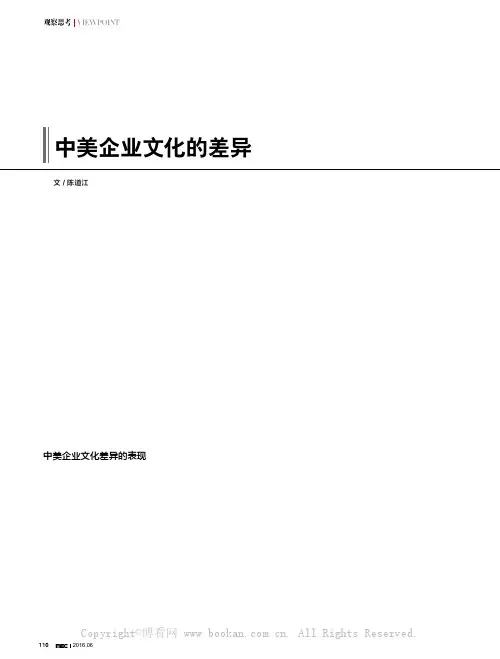
1102016.06企业文化理论形成于美国,是美国的管理学家针对日本企业对美国经济的挑战,研究和总结日本企业管理经验提出的理论。
这一理论创立之初,即被誉为“静悄悄的企业革命”和“现代管理的成功之道”,并在美国企业界广泛运用。
我国的企业特别是国有企业文化形成也经历了长期的发展过程,具备了自身的特色,但与美国的先进企业相比,企业文化建设仍然存在差距和不足。
因此,立足于中美企业所处的大背景即国家文化的差异,对比中美企业文化在企业管理中的不同表现,总结提炼美国企业文化对我国企业发展的借鉴意义,在当前具有十分重要的意义和价值。
中美企业文化差异的表现不同中美文化背景带来的思维方式、沟通方式、法制观念、领导方式上的差异,在企业管理中主要表现在以下方面:管理模式。
美国的市场经济受美国文化背景和价值观念的影响,表现出与其他资本主义国家市场经济不同的方面。
基于价值取向的不同,美国的市场经济被称为个人资本主义。
而中国正处于由传统的计划经济向社会主义市场经济的转型过程中,广泛学习各种先进的管理方式方法,形成有中国特色的社会主义市场经济。
在中美合资企业中,面临管理模式困扰,或由于管理者忽视文化摩擦,而使得跨国公司全球战略遇到障碍。
某一决策在理论上无可挑剔,在实施中却遇到重重阻碍;同一决策,在甲地贯彻实施效果颇佳,在乙地却未必得心应手。
文化造成的摩擦难以通过产品多样化、组织结构复杂化等经营策略来克服,文化造成的偏差只能通过调整文化来纠正。
美国微软公司在管理中对每一个员工灌输正确对待失败、尊重失败的思想,甚至提出“没有失败说明工作没有努力”。
正因为失败成就了微软一次次令对手胆寒的成功。
用微软自己的话说:“失败是成功的一种需要。
”微软公司还大力倡导“释放信息”“工作任意小时”“不需要再开一次会”等管理理念。
这些管理经验和模式非常值得中国国有企业学习和借鉴。
组织结构。
企业组织设计中的文化因素影响,主要体现在两个方面:一是明确个人在组织中的地位和作用,保持一定的权力距离。
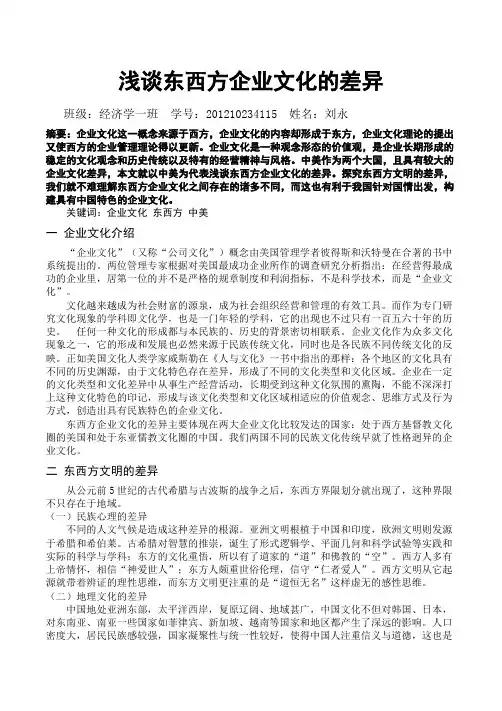
浅谈东西方企业文化的差异班级:经济学一班学号:201210234115 姓名:刘永摘要:企业文化这一概念来源于西方,企业文化的内容却形成于东方,企业文化理论的提出又使西方的企业管理理论得以更新。
企业文化是一种观念形态的价值观,是企业长期形成的稳定的文化观念和历史传统以及特有的经营精神与风格。
中美作为两个大国,且具有较大的企业文化差异,本文就以中美为代表浅谈东西方企业文化的差异。
探究东西方文明的差异,我们就不难理解东西方企业文化之间存在的诸多不同,而这也有利于我国针对国情出发,构建具有中国特色的企业文化。
关键词:企业文化东西方中美一企业文化介绍“企业文化”(又称“公司文化”)概念由美国管理学者彼得斯和沃特曼在合著的书中系统提出的。
两位管理专家根据对美国最成功企业所作的调查研究分析指出:在经营得最成功的企业里,居第一位的并不是严格的规章制度和利润指标,不是科学技术,而是“企业文化”。
文化越来越成为社会财富的源泉,成为社会组织经营和管理的有效工具。
而作为专门研究文化现象的学科即文化学,也是一门年轻的学科,它的出现也不过只有一百五六十年的历史。
任何一种文化的形成都与本民族的、历史的背景密切相联系。
企业文化作为众多文化现象之一,它的形成和发展也必然来源于民族传统文化,同时也是各民族不同传统文化的反映。
正如美国文化人类学家威斯勒在《人与文化》一书中指出的那样:各个地区的文化具有不同的历史渊源,由于文化特色存在差异,形成了不同的文化类型和文化区域。
企业在一定的文化类型和文化差异中从事生产经营活动,长期受到这种文化氛围的熏陶,不能不深深打上这种文化特色的印记,形成与该文化类型和文化区域相适应的价值观念、思维方式及行为方式,创造出具有民族特色的企业文化。
东西方企业文化的差异主要体现在两大企业文化比较发达的国家:处于西方基督教文化圈的美国和处于东亚儒教文化圈的中国。
我们两国不同的民族文化传统早就了性格迥异的企业文化。
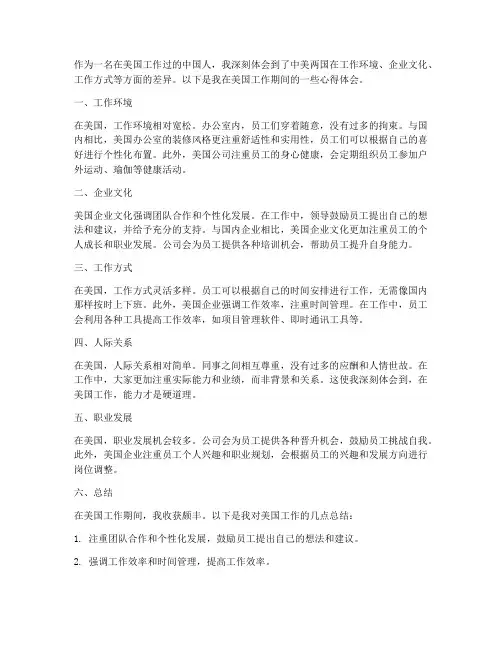
作为一名在美国工作过的中国人,我深刻体会到了中美两国在工作环境、企业文化、工作方式等方面的差异。
以下是我在美国工作期间的一些心得体会。
一、工作环境在美国,工作环境相对宽松。
办公室内,员工们穿着随意,没有过多的拘束。
与国内相比,美国办公室的装修风格更注重舒适性和实用性,员工们可以根据自己的喜好进行个性化布置。
此外,美国公司注重员工的身心健康,会定期组织员工参加户外运动、瑜伽等健康活动。
二、企业文化美国企业文化强调团队合作和个性化发展。
在工作中,领导鼓励员工提出自己的想法和建议,并给予充分的支持。
与国内企业相比,美国企业文化更加注重员工的个人成长和职业发展。
公司会为员工提供各种培训机会,帮助员工提升自身能力。
三、工作方式在美国,工作方式灵活多样。
员工可以根据自己的时间安排进行工作,无需像国内那样按时上下班。
此外,美国企业强调工作效率,注重时间管理。
在工作中,员工会利用各种工具提高工作效率,如项目管理软件、即时通讯工具等。
四、人际关系在美国,人际关系相对简单。
同事之间相互尊重,没有过多的应酬和人情世故。
在工作中,大家更加注重实际能力和业绩,而非背景和关系。
这使我深刻体会到,在美国工作,能力才是硬道理。
五、职业发展在美国,职业发展机会较多。
公司会为员工提供各种晋升机会,鼓励员工挑战自我。
此外,美国企业注重员工个人兴趣和职业规划,会根据员工的兴趣和发展方向进行岗位调整。
六、总结在美国工作期间,我收获颇丰。
以下是我对美国工作的几点总结:1. 注重团队合作和个性化发展,鼓励员工提出自己的想法和建议。
2. 强调工作效率和时间管理,提高工作效率。
3. 人际关系简单,注重实际能力和业绩。
4. 职业发展机会较多,公司为员工提供晋升和培训机会。
5. 工作环境宽松,注重员工身心健康。
总之,在美国工作让我受益匪浅。
我相信,这些经验将对我今后的职业生涯产生积极影响。
在今后的工作中,我会将所学所得运用到实际中,不断提升自己,为我国的发展贡献自己的力量。
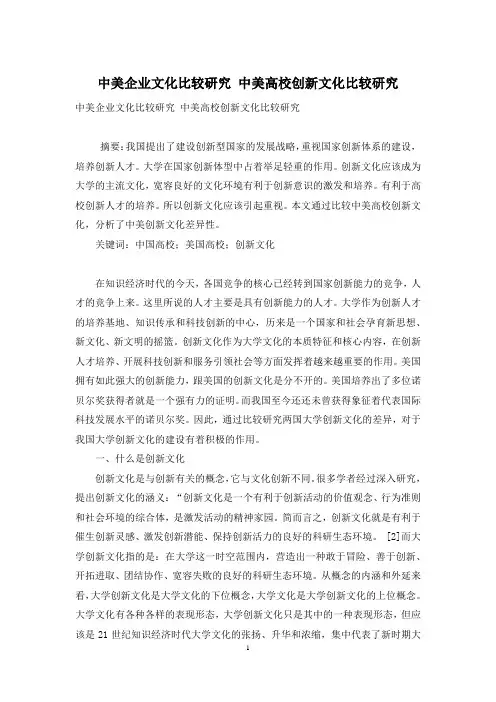
中美企业文化比较研究中美高校创新文化比较研究中美企业文化比较研究中美高校创新文化比较研究摘要:我国提出了建设创新型国家的发展战略,重视国家创新体系的建设,培养创新人才。
大学在国家创新体型中占着举足轻重的作用。
创新文化应该成为大学的主流文化,宽容良好的文化环境有利于创新意识的激发和培养。
有利于高校创新人才的培养。
所以创新文化应该引起重视。
本文通过比较中美高校创新文化,分析了中美创新文化差异性。
关键词:中国高校;美国高校;创新文化在知识经济时代的今天,各国竞争的核心已经转到国家创新能力的竞争,人才的竞争上来。
这里所说的人才主要是具有创新能力的人才。
大学作为创新人才的培养基地、知识传承和科技创新的中心,历来是一个国家和社会孕育新思想、新文化、新文明的摇篮。
创新文化作为大学文化的本质特征和核心内容,在创新人才培养、开展科技创新和服务引领社会等方面发挥着越来越重要的作用。
美国拥有如此强大的创新能力,跟美国的创新文化是分不开的。
美国培养出了多位诺贝尔奖获得者就是一个强有力的证明。
而我国至今还还未曾获得象征着代表国际科技发展水平的诺贝尔奖。
因此,通过比较研究两国大学创新文化的差异,对于我国大学创新文化的建设有着积极的作用。
一、什么是创新文化创新文化是与创新有关的概念,它与文化创新不同。
很多学者经过深入研究,提出创新文化的涵义:“创新文化是一个有利于创新活动的价值观念、行为准则和社会环境的综合体,是激发活动的精神家园。
简而言之,创新文化就是有利于催生创新灵感、激发创新潜能、保持创新活力的良好的科研生态环境。
[2]而大学创新文化指的是:在大学这一时空范围内,营造出一种敢于冒险、善于创新、开拓进取、团结协作、宽容失败的良好的科研生态环境。
从概念的内涵和外延来看,大学创新文化是大学文化的下位概念,大学文化是大学创新文化的上位概念。
大学文化有各种各样的表现形态,大学创新文化只是其中的一种表现形态,但应该是21世纪知识经济时代大学文化的张扬、升华和浓缩,集中代表了新时期大学文化的精髓和要义。
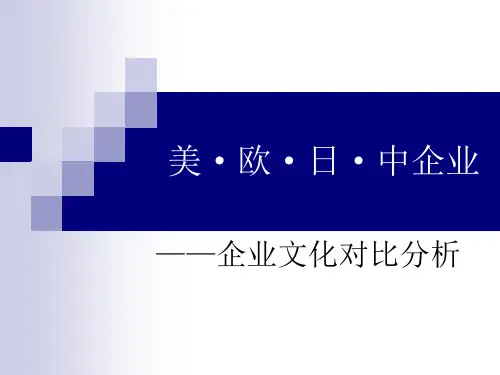
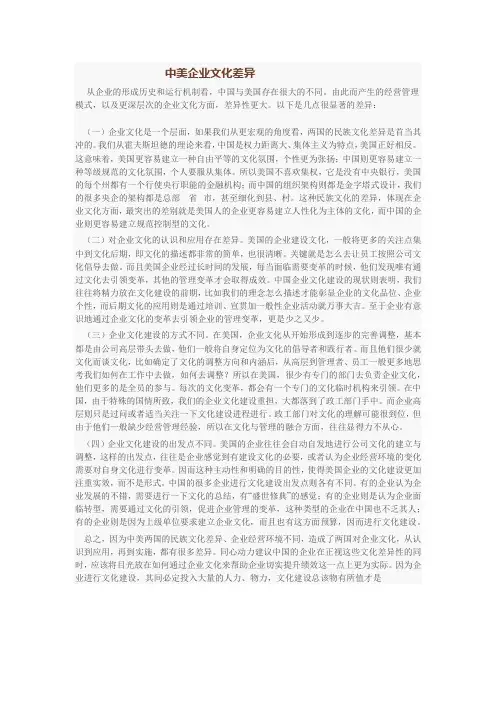
中美企业文化差异从企业的形成历史和运行机制看,中国与美国存在很大的不同。
由此而产生的经营管理模式,以及更深层次的企业文化方面,差异性更大。
以下是几点很显著的差异:(一)企业文化是一个层面,如果我们从更宏观的角度看,两国的民族文化差异是首当其冲的。
我们从霍夫斯坦德的理论来看,中国是权力距离大、集体主义为特点,美国正好相反。
这意味着,美国更容易建立一种自由平等的文化氛围,个性更为张扬;中国则更容易建立一种等级规范的文化氛围,个人要服从集体。
所以美国不喜欢集权,它是没有中央银行,美国的每个州都有一个行使央行职能的金融机构;而中国的组织架构则都是金字塔式设计,我们的很多央企的架构都是总部---省--市,甚至细化到县、村。
这种民族文化的差异,体现在企业文化方面,最突出的差别就是美国人的企业更容易建立人性化为主体的文化,而中国的企业则更容易建立规范控制型的文化。
(二)对企业文化的认识和应用存在差异。
美国的企业建设文化,一般将更多的关注点集中到文化后期,即文化的描述都非常的简单,也很清晰。
关键就是怎么去让员工按照公司文化倡导去做。
而且美国企业经过长时间的发展,每当面临需要变革的时候,他们发现唯有通过文化去引领变革,其他的管理变革才会取得成效。
中国企业文化建设的现状则表明,我们往往将精力放在文化建设的前期,比如我们的理念怎么描述才能彰显企业的文化品位、企业个性,而后期文化的应用则是通过培训、宣贯加一般性企业活动就万事大吉。
至于企业有意识地通过企业文化的变革去引领企业的管理变革,更是少之又少。
(三)企业文化建设的方式不同。
在美国,企业文化从开始形成到逐步的完善调整,基本都是由公司高层带头去做,他们一般将自身定位为文化的倡导者和践行者。
而且他们很少就文化而谈文化,比如确定了文化的调整方向和内涵后,从高层到管理者、员工一般更多地思考我们如何在工作中去做,如何去调整?所以在美国,很少有专门的部门去负责企业文化,他们更多的是全员的参与。
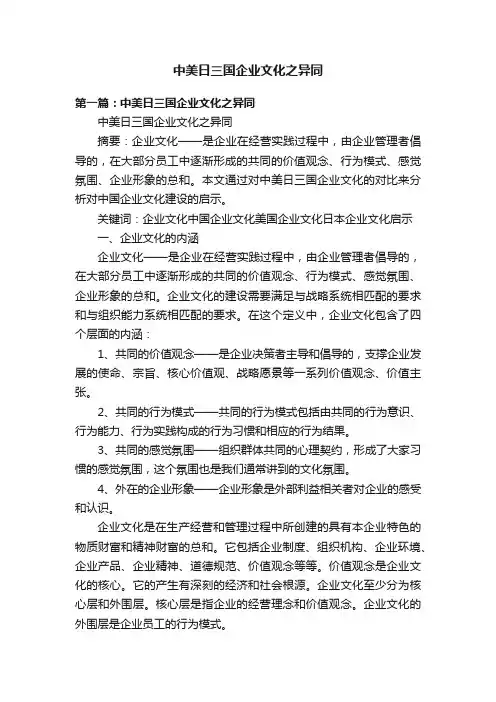
中美日三国企业文化之异同第一篇:中美日三国企业文化之异同中美日三国企业文化之异同摘要:企业文化——是企业在经营实践过程中,由企业管理者倡导的,在大部分员工中逐渐形成的共同的价值观念、行为模式、感觉氛围、企业形象的总和。
本文通过对中美日三国企业文化的对比来分析对中国企业文化建设的启示。
关键词:企业文化中国企业文化美国企业文化日本企业文化启示一、企业文化的内涵企业文化——是企业在经营实践过程中,由企业管理者倡导的,在大部分员工中逐渐形成的共同的价值观念、行为模式、感觉氛围、企业形象的总和。
企业文化的建设需要满足与战略系统相匹配的要求和与组织能力系统相匹配的要求。
在这个定义中,企业文化包含了四个层面的内涵:1、共同的价值观念——是企业决策者主导和倡导的,支撑企业发展的使命、宗旨、核心价值观、战略愿景等一系列价值观念、价值主张。
2、共同的行为模式——共同的行为模式包括由共同的行为意识、行为能力、行为实践构成的行为习惯和相应的行为结果。
3、共同的感觉氛围——组织群体共同的心理契约,形成了大家习惯的感觉氛围,这个氛围也是我们通常讲到的文化氛围。
4、外在的企业形象——企业形象是外部利益相关者对企业的感受和认识。
企业文化是在生产经营和管理过程中所创建的具有本企业特色的物质财富和精神财富的总和。
它包括企业制度、组织机构、企业环境、企业产品、企业精神、道德规范、价值观念等等。
价值观念是企业文化的核心。
它的产生有深刻的经济和社会根源。
企业文化至少分为核心层和外围层。
核心层是指企业的经营理念和价值观念。
企业文化的外围层是企业员工的行为模式。
企业文化在企业起着至关重要的作用,它影响着企业中的每一件事,大至企业决策、人事任命、干部选拔,小至员工的行为举止、衣着爱好;它影响着企业的每时每刻,早至创立之初如何开展业务扩大规模,中至如何维持优势二次创业,后至走向衰退或者基业长青。
具体地说,企业文化的作用有以下五个方面:1、具有企业灵魂的导向作用2、具有团队精神建设的凝聚作用3、具有实现企业振兴的激励作用4、具有行为规范内在的约束作用5、具有企业形象美化的辐射作用二、中国企业管理特色中国企业的发展已经历了百余年。
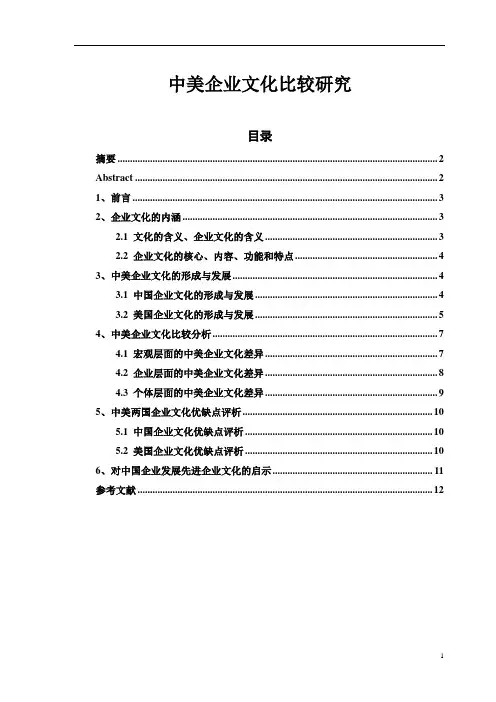
1 中美企业文化比较研究 目录 摘要 ................................................................................................................................ 2 Abstract ......................................................................................................................... 2 1、前言 .......................................................................................................................... 3 2、企业文化的内涵 ...................................................................................................... 3 2.1 文化的含义、企业文化的含义 ..................................................................... 3 2.2 企业文化的核心、内容、功能和特点 ......................................................... 4 3、中美企业文化的形成与发展 .................................................................................. 4 3.1 中国企业文化的形成与发展 ......................................................................... 4 3.2 美国企业文化的形成与发展 ......................................................................... 5 4、中美企业文化比较分析 .......................................................................................... 7 4.1 宏观层面的中美企业文化差异 ..................................................................... 7 4.2 企业层面的中美企业文化差异 ..................................................................... 8 4.3 个体层面的中美企业文化差异 ..................................................................... 9 5、中美两国企业文化优缺点评析 ............................................................................ 10 5.1 中国企业文化优缺点评析 ........................................................................... 10 5.2 美国企业文化优缺点评析 ........................................................................... 10 6、对中国企业发展先进企业文化的启示 ................................................................ 11 参考文献 ...................................................................................................................... 12 2
《商场现代化》2012年3月(中旬刊)总第677期随着世界经济一体化的发展和中国对外开放的深化,中国经济将成为世界经济不可分割的一部分,中国经济的高速发展和巨大的市场需求,将吸引更多的跨国公司把产品销往中国和到中国投资开办分公司。
比较中、美、日企业文化的异同,借鉴国外先进的企业管理经验,对加快国企改革的步伐,促进我国经济发展具有重要的现实意义。
一、美、日企业文化的异同所谓企业文化是指在一定的民族文化传统中逐步形成的具有本企业特色的基本信念、价值观念、经营哲学、道德原则与规范、规章制度、生活方式、人文环境、以及与此相适应的思维方式和行为方式的总和。
美国是一个没有经历封建社会而直接进入资本主义社会的国家,封建社会那种“大家族”式的“群体意识”没有形成,但资本主义私有制所提倡的个人奋斗的个人主义却得到了充分的发展。
日本的资本主义是在封建家族制的基础上发展起来的,封建家族和村庄的群体意识,深深地植根于日本的传统文化之中。
因此,日本文化具有群体的特征,它倡导个体对群体的归属,强调整体的和谐统一。
由于两国的历史文化背景不同,所以表现在企业文化上存在着很大的差异,具体如表:美日企业文化差异一览表虽然,美日企业文化有所不同,但都遵循共同的经济规律,表现在管理上也有其共同的一面。
比如,二者都强调以人为本,想尽一切办法调动雇员的积极性,挖掘人的潜力;都把雇员当作“社会人”而不是“经济人”来管理;企业都以价值观念为核心,使职工有共同遵循的价值观念和行为准则。
进入八十年代后,美日企业文化相互渗透,出现相互融合的趋势。
在个人与团体;契约与人文;能力与资历;权威与民主;理性与非理性等方面,相互补充,取长补短,使企业文化更具有了时代特色。
二、中国企业文化与美日企业文化的异同中国是一个具有古老传统文化的国家,“中庸之道”,“天人合一”,“阳刚”与“阴柔”等思想对企业文化有着深刻的影响。
长久以来,大家庭、家族等集体主义根深蒂固,表现在企业文化上具有伦理性、政治性、观念性、非自主性等特点。
摘要现如今我国的企业文化尚未成熟,要想企业发展好就要不断优化企业文化。
每一个国家环境不同,文化也与其息息相关,形成自己的文化。
不同文化背景下必然存在差异,影响着企业文化的发展。
此文通过我国企业与美国企业的代表两者文化之间的较量,大致突出文化影响的企业文化,找出它们的不同之处,进而推出不同的企业文化给我们带来的启示。
关键词:企业文化文化差异AbstractNowadays, our country’s corporate culture is not mature. If we want to develop well we should constantly improve the corporate culture. Each country's environment is different, and its culture is closely related to it, so as to forming its own culture.Different cultural background cause differences in values, attitudes and behaviors,this affects the development of corporate culture.This article,through the contest between business representatives of tow countries -China and America. we can roughly highlight the corporate culture influenced by culture, find out the differences between them, and then introduce the enlightenment brought by different corporate culture to us.Keywords:Corporate culture Cultural difference目录一、引言 (1)二、中国文化背景 (1)(一)中国文化背景 (1)(二)中国企业文化背景 (1)三、美国文化背景 (2)(一)美国文化背景 (2)(二)美国企业文化背景 (2)四、中国华为和美国苹果企业文化简介 (2)(一)企业文化的概念 (2)(二)中国华为企业文化简介 (2)(三)美国苹果企业文化简介 (3)五、中国华为和美国苹果企业文化的发展历程、现状和特点 (4)(一)中国华为企业文化的发展历程、现状和特点 (4)(二)美国苹果企业文化的发展历程、现状和特点 (5)六、中国华为和美国苹果企业文化对比分析 (6)(一)相同点 (7)(二)不同点 (8)七、企业文化对企业的重要作用 (9)(一)引导企业管理方向 (10)(二)形成员工道德约束 (10)(三)加强员工精神激励 (10)(四)提升企业凝聚力 (10)(五)塑造企业品牌形象 (10)八、中国华为与美国苹果相互转换环境如何适应 (10)(一)华为的强化 (10)(二)苹果的优劣势 (11)九、总结 (12)参考文献: (12)致谢 (13)中国华为和美国苹果企业文化对比分析一、引言自从经济危机和石油危机后,美国学者发现并研究日本的企业从中得到启发,不断追随日本学习和研究他们的企业文化从而对美国的企业得到更好稳定的发展。
美国企业文化对中国企业的启示美国企业文化对中国企业的启示摘要:在经济全球化背景下,企业文化在现代管理中发挥的作用越来越受到关注。
美国是现代管理理论的主要发源地,在许多成功的美国企业中,无一例外地拥有独具特色的企业文化,如管理授权、鼓励创新、以人为本等,与中国企业文化特点有相当差异。
构建先进的中国企业文化应学习美国企业文化的优点,强调依法管理,明确权力责任,塑造团队精神等。
关键词:企业文化;权变管理;科学管理;团队精神;学习型企业企业文化是现代管理科学发展的重要组成部分,它包括文化观念、价值观念、企业精神、道德规范、行为准则、历史传统、企业制度、文化环境、企业产品等。
其中,价值观是企业文化的核心。
[1](p33)不同国家的文化差异、民族文化差异、经济和技术发展水平都会影响企业文化的形成,并对企业的发展产生不同的影响。
现代企业管理经验表明,企业经营的最高境界是文化经营,企业最终的竞争是文化竞争。
文化已经成为提升企业品牌的重要手段,也是整合企业内外部资源的最有力、最经济、最高效的“无形之手”。
翻开近代世界经济发展史,全球规模的大企业,尤其在世界500强企业行列中,美国企业几乎占据了一半以上的份额。
即使在当今瞬息万变的经济环境下,美国的企业还是保持着世界第一的竞争力。
因此,研究美国企业文化的特点,探讨美国企业文化与中国企业文化之间的异同,引进和学习西方先进的文化管理理念,是摆在中国企业和企业管理者面前的一个课题。
一、美国企业文化的特点美国文化可归属于低度关系文化,他们相信人人生来平等。
[2]由于其建国历史不长,因此没有沉重的传统文化包袱,加上美国以移民为主,荟萃了世界众多的优秀人才,使其文化具有较强的融合性。
美国企业文化特点,归纳起来主要体现在以下几个方面:1.以人为中心的管理理念。
美国社会十分重视突出个人的作用,强调尊重和信任个人,通过个人奋斗实现自我价值。
美国所有的优秀企业都把信任人、尊重人、关心人作为企业管理的出发点,把人而不是把资本或设备作为提高劳动生产率的源泉。
中美史克“3T文化”:相互信任开放透明积极主动2008-4-27 14:25:53简要内容:3T是三个英文单词的缩写,代表相互信任(Trust)、开放透明(Transparent)、积极主动(Take initiative)。
我们新任总经理2007年1月加入公司,他务实、高效,在管理上特别强调openness——公开和开放。
全体员工也为要将企业发展成中国最大最好的OTC 和保健品企业的目标而振奋。
这个时候,我们需要一个全新的工作方式,能让整个企业更加高效地、充满热情和活力地快速发展。
纪云,中美史克人力资源总监。
2004年10月加盟中美史克,之前在埃克森美孚石油公司、奥的斯电梯公司从事人力资源管理工作。
记者:我们知道,现在很多企业都越来越认识到企业文化的重要作用,都在做企业文化建设,中美史克的“3T文化”在业界影响很大,请具体谈一下“3T文化”的含义和来历吧?纪云:3T是三个英文单词的缩写,代表相互信任(Trust)、开放透明(Transparent)、积极主动(Take initiative)。
我们新任总经理2007年1月加入公司,他务实、高效,在管理上特别强调openness——公开和开放。
全体员工也为要将企业发展成中国最大最好的OTC 和保健品企业的目标而振奋。
这个时候,我们需要一个全新的工作方式,能让整个企业更加高效地、充满热情和活力地快速发展。
记者:3T文化是来自“民意”?纪云:是的。
在公司2007年2月的东莞年会期间,我们和30多个高级经理会聚一堂,请大家用绘画的方式来表达自己对企业新的工作方式的渴望。
当大家的“作品”拼合在一起的时候,画面呈现出内心的激动与渴望竟然惊人地一致:大家期望的是能够彼此信任,在开放的、无障碍的沟通环境中充满激情地工作,实现公司的目标和个人的职业梦想。
我们就将大家的渴望浓缩成看似简单却真的不平凡的“3T”文化。
记者:现在很多企业的文化建设,通常容易流于表面和形式,那么“3T文化”是怎样在中美史克实践推广的呢?纪云:企业文化的目的是为了最终启动员工“行为”的转变。
中美企业文化的碰撞引言随着全球化的深入发展,中美企业之间的交流与合作日益频繁,中美企业文化的碰撞也变得愈发明显。
中美企业文化的差异不仅体现在价值观、管理风格等方面,更深层次地影响着企业战略、组织结构、沟通方式等诸多方面。
本文将围绕中美企业文化的碰撞展开讨论,并分析其对企业发展的影响。
1. 价值观和理念的不同中美企业文化在价值观和理念上存在较大差异。
传统的中国企业文化注重家族观念、集体主义和尊重权威;而美国企业文化则强调个人主义、竞争和追求卓越。
这种价值观的差异在企业中不同的决策、行为和做事方式上体现得淋漓尽致。
在中美企业文化碰撞的过程中,中国企业需要更加注重个人能力的培养、员工激励机制的建立,以及注重创新和自由的思维方式。
而美国企业则需要了解和尊重中国的集体主义文化,适应中国的社会环境和制度,避免形成文化冲突和误解。
2. 管理风格的差异中美企业的管理风格也存在差异。
中国企业在管理中往往注重组织的层级性、权威性和稳定性,强调集中决策和命令式管理;而美国企业则更加注重员工的自主性、开放性和平等性,倡导分权和团队合作。
这种管理风格的差异在企业合作、协同和决策过程中往往导致摩擦和障碍。
为了更好地实现中美企业之间的合作和沟通,双方需要学习和借鉴彼此的管理经验,逐步调整和改进自己的管理风格。
3. 企业战略和发展方向的差异中美企业在战略和发展方向上也有明显的差异。
中国企业在发展过程中往往更加注重长期规划、稳定发展和资源整合;而美国企业则更加注重创新、快速反应和市场占有率的增长。
这种战略和发展方向的差异在企业合作和竞争中形成了一定的冲突。
中国企业需要学会更加灵活和快速地应对市场需求和变化,注重创新和创造新的商业模式;而美国企业则需要更加注重稳定和可持续发展,深入了解中国市场和文化,以便更好地与中国企业合作和竞争。
4. 沟通方式和合作机制的不同中美企业文化的碰撞也表现在沟通方式和合作机制上。
中国企业往往注重隐晦的表达方式、间接的沟通方式和面子文化;而美国企业则更加注重直接、开放、坦诚的沟通方式。
xxx学院本科毕业论文中美合资企业企业文化建设对策研究学生姓名: xx学生学号:院(系):经济与管理学院年级专业:国际经济与贸易指导教师: xxx 教授二〇一三年六月摘要在经济全球化的新形势下,企业文化的竞争成为市场竞争的核心内容,跨国企业综合实力的强弱就体现在企业文化方面。
本文通过对企业文化建设和跨文化企业文化建设的理论研究,分析中美合资企业企业文化差异及中美合资企业文化建设的现状,通过结合相关案例,分析中美合资企业企业文化建设所取得的经验和所存在的问题,并提出成立专门的企业文化建设机构;分析合资企业内部文化差异,有效地进行企业文化选择;确立统一的规章制度和行为规范等解决这些问题的相关对策。
本文共分为五章,第一章和第二章分别对企业文化和跨文化企业文化的相关问题进行概述,重点分析了企业文化的功能和影响因素以及跨文化企业文化建设的重要性和难点。
第三章对比分析了中美文化以及中美企业文化的差异。
第四章通过三个案例重点分析中美合资企业企业文化建设所面临的问题。
最后一章针对前文分析的中美合资企业企业文化建设所面临的问题,提出相应的对策。
关键词中美合资企业,跨文化企业文化,文化差异,文化融合ABSTRACTIn the new situation of economic globalization ,the corporate culture of competition to become the core of market competition ,the strength of the comprehensive strength of multinational corporations is reflected in the corporate culture .This article based on the corporate culture and the cross-culture theory of corporate culture research ,analysis of sino-us joint venture enterprise cultural differences and the present situation of the sino-us joint venture enterprise culture construction ,by combining with the related cases ,analysis of sino-us joint venture enterprise culture construction experience and the existing problems ,and puts forward the relevant countermeasures to solve these problems .For example :set up a special enterprise culture construction ;Analysis of internal cultural differences in joint venture ,and effectively select the corporate culture ;Establishing unified rules and regulations and code of conduct ,etc.This paper is divided into five chapters ,the first chapter and second chapter ,respectively ,summarized the related problems of the enterprise culture and cross-cultural enterprise culture ,analyzed the importance and difficulty of the function and influence factors of enterprise culture and cross-cultural enterprise culture construction .The third chapter comparative analysis the different culture between China and the United States and the differences of sino-american corporate culture .The fourth chapter by analyzing three cases focus on sino-us joint venture enterprise culture construction problems faced .Last chapter in view of the analysis of sino-us joint venture enterprise culture construction problems faced ,put forward the corresponding countermeasures.Keywords sino-us venture , cross-cultural enterprise culture, cultural differences , cultural fusion目录摘要 (I)ABSTRACT (II)绪论 (1)一、企业文化概述 (2)(一)企业文化的概念和结构 (2)(二)企业文化的功能 (2)(三)企业文化的影响因素 (3)二、跨文化企业文化的相关问题 (4)(一)跨文化企业文化的含义和特点 (4)(二)跨文化企业文化建设的重要性 (4)(三)跨文化企业文化建设的难点 (5)1.企业内部文化的多样性和冲突性 (5)2.企业内部文化即有积极性又有消极性 (5)3.企业内部文化具有渐进性 (5)三、中美企业文化差异 (6)(一)中美文化差异 (6)1.集体主义与个人主义 (6)2.依赖与独立 (6)3.“和”与“争”、“稳”与“变” (6)4.“面子”与“事实” (6)(二)中美企业文化差异 (7)四、中美合资企业企业文化建设案例分析 (9)(一)中美合资企业企业文化建设发展现状 (9)(二)中美合资企业企业文化建设案例举要 (9)1.上海通用汽车有限公司 (9)2.可口可乐公司 (10)3.荣事达中美合资公司 (10)(三)中美合资企业企业文化建设所存在的问题 (11)1.价值理念和经营理念的冲突 (11)2.文化融合意识落后 (11)3.对企业文化理念认识不足 (11)4.建设中存在片面性、盲目性,缺乏现实性和创新性 (12)5.内部缺乏交流,企业文化没有号召力 (12)五、中美合资企业企业文化建设对策 (13)(一)成立专门的企业文化建设机构 (13)(二)分析合资企业内部文化差异,有效地进行文化选择 (13)(三)建立共同的价值观念和有特色的新型企业文化 (13)(四)确立统一的规章制度和行为准则规范 (14)(五)以人为本,增强企业的凝聚力和向心力 (14)结论 ..................................................................................................... 错误!未定义书签。
摘要:本文分别通过对中美两国企业文化的形成与发展、现状和特点的比较,探讨在不同国家
文化背景下的各具特色的企业文化。
关键词:中美企业;企业文化
“企业文化”(又称“公司文化”)概念由美国管理学者彼得斯和沃特曼在合著的书中系统
提出的。两位管理专家根据对美国最成功企业所作的调查研究分析指出:在经营得最成功的
企业里,居第一位的并不是严格的规章制度和利润指标,不是科学技术,而是“企业文化”。
一、美国的企业文化
(一)美国企业文化的形成与发展
经过70年代石油危机和货币危机之后进入80年代,美国的传统制造业受到很大的冲击,
企业竞争力日益下降。而日本却仅凭一种更先进的管理模式安然无恙。这使得美国的企业管
理研究者和实际工作者开始对日本模式进行研究,纷纷赴日取经,挖掘日本企业成功的秘密。
“赴日淘金”热潮,引发了美国理论界对企业文化的深切关注,以及对美国本土企业文化的深
刻反思,认识到企业文化这种“软件”所发挥的重大作用,试举例加以说明。
美国德克萨斯州一家电视机厂,因经营不善而濒临倒闭,老板决定请日本人来接管。七
年后,产品的数量和质量都达到了历史最高水平,日本人靠什么?就是靠尊重人的优秀企业
文化。表现在:第一、接管之初,新任经理把员工们召集在一起,不是指责嘲笑他们的失败,
而是请他们喝咖啡聚会,向每位员工赠送一台半导体收音机。第
二、日本经理主动地拜会工会负责人,希望“多多关照”,力图使美国工人解除心理戒备,
在感情上与日本人靠拢。第三、工厂生产有了起色以后,日本经理把以前被该厂解雇的老职
工全部找回去重新任用,以培育工人们的“报恩之心”。
20世纪80年代以后,美国的企业形成了符合企业经营哲学和经营战略的企业文化。
(二)美国企业文化现状
美国是一个移民国家,文化根基浅,僵化的传统不多,全社会都重视突出个人的作用。
这种文化在企业里,首先表现为尊重个人的尊严和价值,以及对员工的充分信任。“品质第一,
顾客至上”也是构成美国企业文化的重要组成部分。
(三)美国企业文化的特点
1、 重视自我价值的实现。
2、提倡竞争和献身。福特公司的前总裁亨利.福特说:最高职位是不能遗传的,只能靠
自己去争取。
3、奖励创新。3M公司的成功在于创新有绝招,招招都很妙。3M公司不轻易扼杀一个
设想,如果一个设想在3M各部门找不到归宿,设想者可以利用15%的工作时间来证明自己
的设想是正确的。
4、利益共享。美国最大的连锁店沃尔玛公司、希尔顿公司,均将一部分股份作为工资或
福利分给职工。
(四)美国企业文化的成功典范
美国企业文化在20世纪80年代以后迅速发展,许多企业都建立了其独具特色的企业文
化,并凭此形成了企业强大的凝聚力,如IBM、摩托罗拉和朗讯等。
我们看看摩托罗拉以“人本管理”的企业文化:摩托罗拉公司自成立之日起,它的根本宗
旨就是尊重人性,为员工、客户和社会做有益的事情,并将之作为指导企业发展的最高准则。
其之所以在全球取得巨大的成功,很大程度上归因于它坚持了人本管理。在摩托罗拉,人的
尊严被定义为:实质性的工作;了解成功的条件;有充分的培训并能胜任工作;在公司有明
确的个人前途;及时中肯的反馈;无偏见的工作环境。
二、中国的企业文化
(一)中国企业文化的形成与发展
1、 解放前民族资本企业中萌芽的企业文化
中国近代工业创建以来产生了一大批优秀的民族资本企业,代表了中国早期具有独立商
品生产经营组织性质的企业文化的萌芽。
2、建国初期社会主义公有制企业的企业文化
这一时期我国企业文化具有三个特点:第一、政治性。第二、伦理性。第三、主动性,
如“铁人精神”就是这一时期企业文化的代表。
3、改革初期转型阶段的企业文化
主要有三个特点:第一、信仰模糊化。第二、不适应性。第三、非平衡性。
(二)中国企业文化现状
近20年来,随着我国改革开放进程的不断推进,我国企业文化的理论研究和实践正不断
加强,使得人们越来越认识到企业文化的重大价值,许多企业也开始有意识地培育企业文化。
其现状表现在以下方面:
①残酷的事实和激烈的市场竞争唤醒了众多的企业领导人“人才是第一资源”的意识。
②诚实守信乃为人之道,立身之本,是企业精神第一要义,目前正逐步渗透到企业文化
的核心层。
③“学习型组织”的企业文化已受到更多的关注。
(三)中国企业文化的特点
第一,从内涵上看,还缺乏严格意义上的企业价值观,企业核心理念尚未形成。
第二,从结构上看,尚停留在表层和中间层,对企业文化的三个主要板块,即企业价值
观、企业精神、企业形象之间缺乏通盘考虑,没有形成一个整体。
第三,从状态上看,我国的企业文化,明显具有“发展不平衡”的特征。
第四,从内容上看,我国企业文化具有以邓小平理论、三个代表为价值导向的基本特征。
中国企业文化还有两个最显著的特点:一、中国企业文化的基础是优秀的传统文化。传
统文化的其他分支文化,诸子百家,包括兵法、谋略等也都被企业文化分别的吸收。如:兵
家的管理思想──深谋远虑等。二、不同文化的交流渗透成为普遍现象,如“顾客至上”、“产
销统一”等。
(四)中国企业文化案例
改革开放以来特别是入世以后,企业文化越来越受到我国企业界的广泛关注和重视。海
尔、联想等在企业文化方面做得比较成功。如联想的企业文化
联想的企业文化主要包括以下几个方面:
① 提倡爱国主义。“联想人与联想精神”,这个问题是联想文化的主旨。“爱国主义精神”
是这种主旨的体现。
② 提倡合作精神。联想对合作精神有近乎苛刻的要求。联想套用计算机术语,把善于与
人合作的部门和人称“界面友好”,反之则“界面不友好”。
③提倡拼搏精神。“把5%的希望变成100%的现实”是联想拼搏精神的直接反映。
④强调以信为本。联想文化主要是提倡两种信誉,一是个人的信誉,要求是:踏实做事,
说到做到,点滴积累;取信于用户,取信于同仁,取信于上级,取信于下级,取信于政府。
二是公司的信誉,要求是:以用户效益求公司效益;宁可损失金钱,绝不丧失信誉。
⑤提倡服务大众。联想集团提出“客户效益第一,联想效益第二”的服务观念,并把这种
观念纳入到企业文化建设的范畴里。
三、中美企业文化比较分析
美国企业文化的特点是“理性主义企业文化”,表现为浓烈的个人主义,以自身利益为第
一位,讲究“求实、求生存”,它着意创新的精神、功利主义和重视制度管理,在企业管理及
处事中讲究原则性,“法治”观念较强。而中国则是强调群体和谐,注重个体对群体的责任、
奉献和服务,个人归属意识强,注重协调感情,它着意创新精神、民族主义和爱国主义,在
企业管理及处事中以情为重、忽略制度和条例管理,“人治”观念较强。
中国的企业文化建设刚刚起步,广泛地学习和借鉴发达国家的经验显得尤为必要。要发
展有中国特色的企业文化,就要立足中国文化背景,从理论和实践两方面着手,在借鉴国外
企业文化研究的理论和方法的基础上,加强中国的企业文化研究和对实践的理论指导,使中
国企业文化发展适应中国的企业管理实践和现代化进程。
参考文献
[1] 李长禄:《企业人力资源管理开发与管理》,大连理工大学出版社,2006。
[2] 刘永安、廖学军:《美国企业人力资源管理的主要特点》[J],企业经济,2003。
[3] 李静:《国外名企用人之道》,经贸世界,2003.2。
[4] 张岩松、李健:《人力资源管理案例精选精析》,经济管理出版社,2005。
[5] 陈晓:《联想集团的考核机制》,企业管理,2001.2。